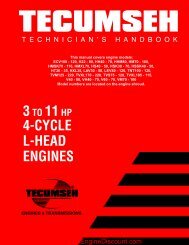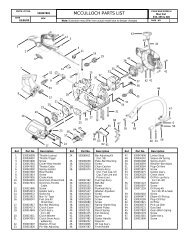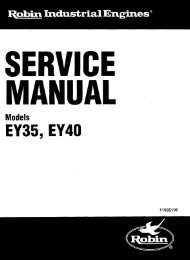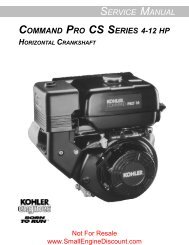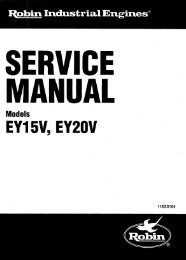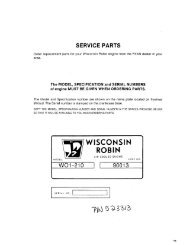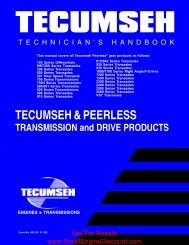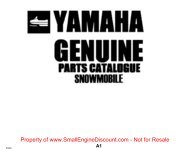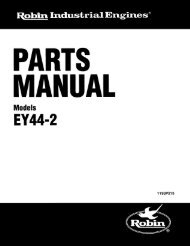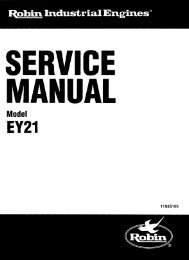EC05-2 - Jacks Small Engines
EC05-2 - Jacks Small Engines
EC05-2 - Jacks Small Engines
Create successful ePaper yourself
Turn your PDF publications into a flip-book with our unique Google optimized e-Paper software.
9-1 CONSTRUCTION and OPERATION<br />
9-1-1 FLOAT SYSTEM<br />
The float chamber is located just below carburetor main body and serves to maintain the fuel level at a constant height by a<br />
joint action of float (F) and needle valve (NV) incorporated. The fuel flows from the fuel tank into float chamber via needle<br />
valve, which is kept open while the fuel level is low, but closed when the fuel level reaches a predetermined level causing the<br />
float to move up.<br />
9-1-2 THROTTLE VALVE<br />
The throttle valve is operated by the control lever and controls the amount of air-fuel mixture and controls engine output<br />
power.<br />
The richness of mixture or the air-fuel ratio is automatically regulated at the optimum valve regardless of the throttle valve<br />
position.<br />
9-1-3 CHOKE VALVE<br />
The choke valve is operated by the choke lever and when it is closed, the air-fuel mixture becomes rich, and as it is opened<br />
the more, the leaner will be the mixture. The choke system serves to facilitate start-up in cold season. When engine is<br />
cranked with choke closed, the negative pressure to main nozzle increases to introduce fuel in large quantities to make<br />
start-up easy.<br />
9-1-4 PILOT SYSTEM and MAIN SYSTEM<br />
This pilot system feeds fuel to engine during idle and slow speed operation.<br />
The fuel fed through main jet (MJ) is measured by pilot jet (PJ), mixed with air measured by pilot air jet (PAJ), regulated<br />
by pilot screw, and then fed to engine through pilot outlet (PO) and bypass (BP).<br />
The fuel is mainly fed from pilot outlet (PO) during idling.<br />
This main system feeds fuel to engine during medium and high-speed operation.<br />
The air measured by main air jet (MAJ) is mixed into fuel through bleed holes of main nozzle (MN) and discharged to main<br />
bore (MB) as atomized fuel where it is mixed with intake air through air cleaner to become an optimum air-fuel mixture to<br />
be supplied to engine.<br />
9-2 DISASSEMBLY and REASSEMBLY (Fig. 9-2)<br />
Besides mechanical failures, most trouble are caused. by incorrect mixing ratio. The most common causes of such incorrect<br />
fuel-air mixtures are clogged jets, restricted air and fuel passages, and variations in fuel level, In order to obtain the full<br />
performance of carburetor, it is necessary to keep air cleaner and carburetor clean so that air and fuel flow without any<br />
restriction.<br />
Observe following disassembly and reassembly procedures. (see Fig. 9-2)<br />
CAUTION: AFTER DISASSEMBLY, CLEAN ALL PARTS IN A SUITABLE SOLVENT, ALL JETS AND VALVES<br />
SHOULD BE BLOWN OUT WITH FRESH COMPRESSED AIR, NEV€R USE A DRILL OR WIRE TO CLEAN OUT<br />
JETS OR IDLE HOLES.<br />
- 39 -




